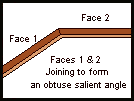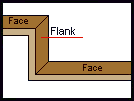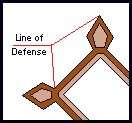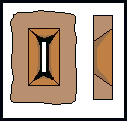
Civil War Field Fortifications
A Glossary of Terms Applied to Civil War Field Fortifications
F - L
Word List
Click on a word to jump to its definition.
| Fraise |
|
|
|||||||||||||
 |
The faces of field works were the stretches of parapet extending from one angle in the work to the next that were designed to provide a direct fire on an attacking body of troops as they advanced up the glacis. | ||
| Back to Main Word List |
 |
Fascines were tightly bound bundles of two inch thick sticks (or fagots) that were used to revet slopes and to cover excessively wet or marshy ground. | ||
| Back to Main Word List |
 |
The flanks, or flanking faces, of a field work were stretches of parapet positioned to produce columns of fire that would strike an attacking body of troops with either a slant or enfilade fire. They were essential for covering the ditch with enfilade fire and providing fire across sectors without fire in front of salient angles. | ||
| Back to Main Word List |
 |
Fougasses were small mines placed in the ditches or at the salient angles of field works. A stone fougass consisted of a slanted conical pit about five feet deep with a charge of powder at the base which was covered by heavy timber and a layer of small stones and pebbles. The mine was supposed to be detonated as enemy troops passed over it and would cover an area about 60 by 70 yards with debris. Another type of mine used by the Russians in the Crimean War was described in Scott's Military Dictionary as consisting of a water tight box filled with powder that was covered by a plate that when stepped on pushed down on a rammer that broke a glass containing sulfuric acid. The acid reacted rather violently with a substance coating the glass and detonated the powder. Neither of these types of mines were in common use in the defense of field fortifications during the Civil War. Other types of mines, called "Torpedoes," that were either mechanically or electrically fired were used, particularly at large sea coast field fortifications such as Fort Wagner and Fort Fisher. | ||
| Back to Main Word List |
 |
Fraises and palisadings both consisted of a line of closely spaced palisades, they differed more in attitude and location than in form. A palisade was a beam 10 to 12 feet long cut in the shape of a triangle with one end sharpened to point. A fraise was a line of palisades planted either horizontally or at a slight downward angle on the scarp, berme, or exterior slope of a field work. Its main purpose was to present an overhead obstacle to an enemy who had entered the ditch of a work. The points of a fraise were supposed to be at least seven feet above the bottom of the ditch to prevent the enemy from using them to climb up the scarp. The points were not supposed to reach past the foot of the scarp so that they wouldn't get in the way when the garrison rolled large stones, logs, and artillery shells down on the enemy in the ditch. Fraises had to built low enough for the glacis or the counterscarp to protect them against artillery fire, a condition that precluded their use in most field works. |
||
| Back to Main Word List |
 |
Gabions were wicker work baskets about three feet high and two feet in diameter without either top or bottom. They were used to revet slopes by placing them position and filling them with soil. | ||
| Back to Main Word List |
A gabionade was any field work constructed of gabions. A traverse, for example, revetted on all four sides with two or more layers of gabions was called a gabionade.
Also See the Detailed Note on Gabions and Gabionades
Back to List? Back to Main Word List
 |
The gorge of a field work was the face that contained the sally-port or entrance to the work. Unenclosed works such as redans and lunettes were said to be open at the gorge since their entrances were not covered by parapets. | ||
| Back to Main Word List |
 |
Inundations could be created by damming streams that passed in front of field works. To be an effective obstacle the water level in the pool created by a dam had to be at least six feet deep, when this depth could not be achieved, trous de loup could be dug along the stream bed and allowed to cover with water. This type of obstacle was rarely used in the Civil War, but at Knoxville, Tennessee, sections of the Federal defenses were partially protected by damming First and Second creeks. | ||
| Back to Main Word List |
 |
A line of defense was the distance between the capital of a salient angle and the nearest re-entering angle that provided fire across the face of the parapet forming the salient angle. It was usually only applied to bastioned fronts and described the area in front of the work where fire from a flanking face crossed the fire from the face of the salient angle and any curtain or other length of parapet between them. | ||
| Back to Main Word List |
 |
Loop-holes were small openings cut into building walls and stockades or formed from sand-bags and other resistant material along the superior slopes of parapets that allowed troops to fire while under cover. Loop-holes were usually splayed inward to allow troops to point their muskets in all directions. | ||
| Back to Main Word List |
Contents Home Page Major Works Minor Works Siege Works Permanent Fortifications
Copyright (c)PEMcDuffie 1997, 1998